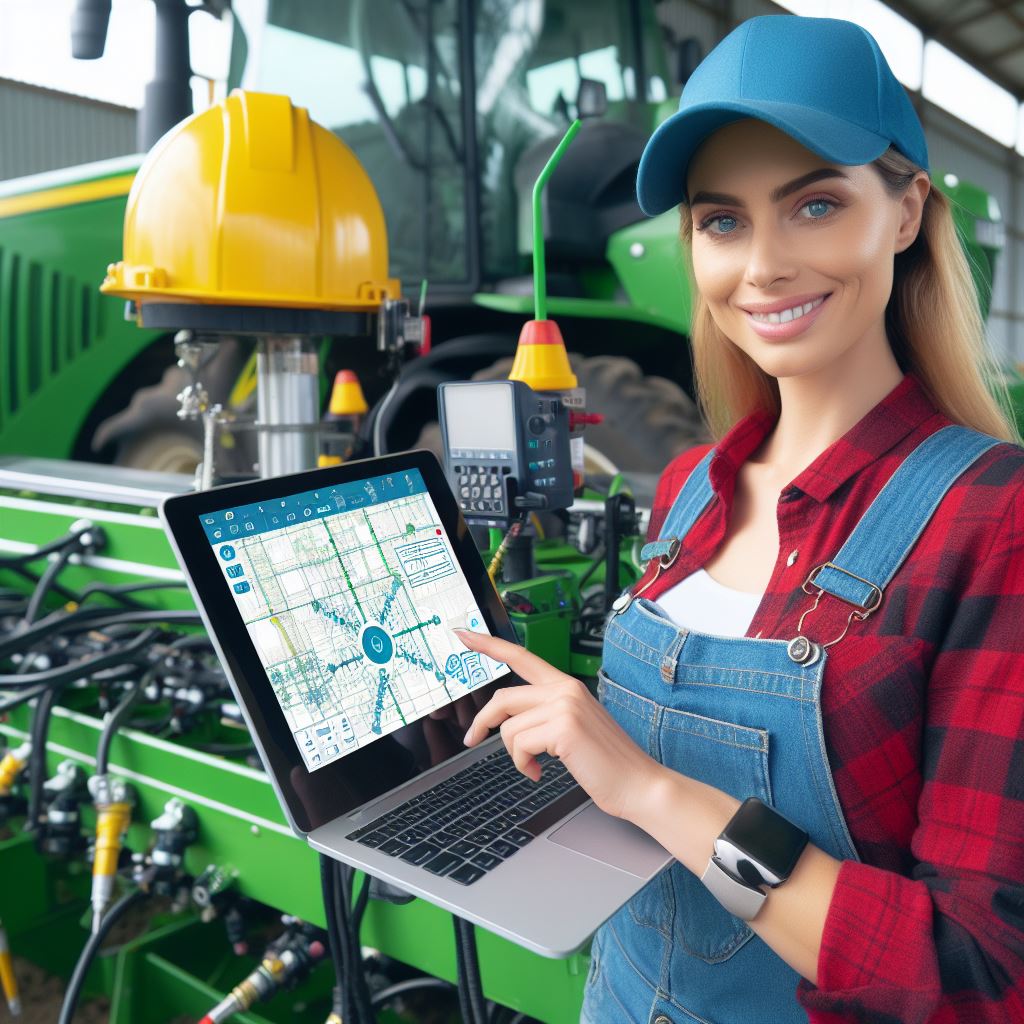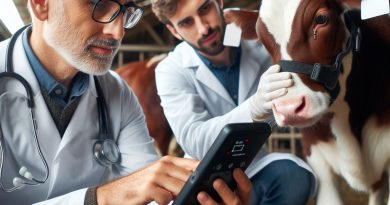Automation in Agriculture: Pros & Cons
Last Updated on January 18, 2024
Introduction
Definition of automation in agriculture
Automation in agriculture refers to the use of technology and machines to perform tasks previously done by humans.
It plays a crucial role in increasing efficiency, reducing labor costs, and improving food production.
This blog post aims to explore the pros and cons of automation in agriculture while highlighting its importance in modern farming practices.
The definition of automation in agriculture involves the application of various technologies such as robotics, drones, and artificial intelligence to automate tasks such as planting, irrigation, harvesting, and crop monitoring.
These technological advancements eliminate the need for manual labor and increase productivity.
Importance and relevance of the topic
The topic of automation in agriculture is essential and relevant due to its potential to revolutionize the farming industry.
With the global population continuously growing, the demand for food production is increasing, and automation can help meet these needs efficiently.
It also addresses challenges such as climate change, limited resources, and a shortage of agricultural workers.
Brief overview of the pros and cons
The advantages of automation include increased efficiency, reduced labor costs, and improved accuracy.
Automated systems can perform tasks at a faster rate and with fewer errors compared to humans.
This results in higher crop yields and more precise application of fertilizers and pesticides, leading to sustainable farming practices.
However, automation in agriculture also poses certain challenges and disadvantages.
It can lead to job displacement, as machines replace manual labor, impacting employment opportunities in rural areas.
Additionally, the initial investment in automation technology can be costly for small-scale farmers, limiting their access to its benefits.
Basically, automation in agriculture presents both opportunities and challenges.
With its ability to increase productivity and address global food demands, it is a significant development in farming practices.
However, careful consideration must be given to its potential impact on employment and accessibility.
Finding a balance between automation and human involvement is crucial for a sustainable future in agriculture.
Read: Climate Smart Agri: Tools & Techniques
Pros of Automation in Agriculture
Automation in agriculture has brought about several benefits, revolutionizing the industry.
Let’s explore the positive aspects of incorporating automation in farming practices.
Increased efficiency and productivity
One significant advantage of automation is its ability to enhance efficiency and productivity in agriculture.
Precision agriculture techniques have emerged as a valuable tool in achieving this goal.
By leveraging technologies such as GPS and drones, farmers can optimize field operations.
These techniques enable accurate mapping, monitoring, and analysis of fields, leading to more targeted and effective resource allocation.
Consequently, this results in increased efficiency and ultimately boosts overall productivity.
Cost savings and reduced labor
Automation also brings cost savings to agricultural operations.
One example of this is the utilization of robots for repetitive tasks.
Robots can replace human labor in activities like seeding, weeding, and harvesting.
Not only does this reduce the need for a large workforce, but it also minimizes costs associated with hiring and managing human workers.
Additionally, robots are capable of working around the clock, leading to higher output levels and potentially reducing the time required to complete tasks.
Improvements in crop quality and yield
Automation plays a crucial role in improving crop quality and yield.
Automated irrigation systems are a prime example of this.
These systems monitor soil moisture levels and other environmental factors in real-time.
By delivering the precise amount of water needed at the right time, crops receive optimal irrigation.
This ensures healthier growth, reduces water waste, and enhances overall crop quality.
Moreover, automated systems can adjust irrigation based on various factors, such as weather conditions, leading to further improvements in yield.
Better monitoring and data collection
Automation facilitates better monitoring and data collection, enabling farmers to make data-driven decisions.
Sensor technology allows for precise monitoring of factors like soil moisture, temperature, and nutrient levels.
This data helps farmers identify the specific needs of their crops and make more informed choices regarding resource allocation.
By understanding the unique requirements of each field, farmers can optimize input usage, minimize waste, and maximize output.
This level of detailed monitoring and real-time data collection contributes to improved overall crop management.
Essentially, automation in agriculture brings significant advantages to the industry.
It enhances efficiency and productivity by utilizing precision techniques and technologies.
Furthermore, cost savings and reduced labor are realized through the integration of robots for repetitive tasks.
Crop quality and yield benefit from automated irrigation systems, while better monitoring and data collection enable farmers to make informed decisions.
These pros demonstrate the potential of automation to revolutionize and improve the agricultural sector.
Read: Sustainable Farming via Tech Innovations

Cons of Automation in Agriculture
Initial high investment cost
While automation promises enhanced efficiency and productivity, adopting these technologies in agriculture does come with some downsides.
Firstly, there is a high upfront investment cost associated with acquiring automated equipment like driverless tractors, robotic harvesters and monitoring sensors.
Job displacement and impact on rural communities
For smaller farms, these costs may be prohibitive.
There are also concerns about job losses and negative effects on rural communities as traditional agricultural roles become automated.
Farm workers displaced by automation may struggle to find new employment in rural areas.
Reliance on technology and potential vulnerabilities
Increased reliance on technology exposes farms to potential disruptions from technical glitches and vulnerabilities like cyber attacks.
With vital systems automated, technical failures could severely impact production.
Ethical and environmental considerations
Finally, ethical and environmental considerations arise regarding aspects like genetic modification and pesticide use.
While automation enables precision application, some worry about excessive use enabled by technology.
In general, drawbacks of agricultural automation include high initial costs, job losses, over-reliance on technology and ethical concerns.
An example is the potential displacement of manual fruit pickers by robotic harvesting systems.
While promising benefits like improved productivity, farmers must weigh if potential downsides impact rural economies or environment.
Thoughtful and responsible implementation of agriculture automation is key.
Read: Drones in Agri: Irrigation Game Changer
Balancing Automation and Human Labor
Agriculture is an essential industry that provides food and resources to sustain our growing population.
With the advancement of technology, automation has become a significant player in transforming agricultural practices.
However, finding the right balance between automation and human labor is crucial for the industry’s sustainable growth and success.
Importance of finding the right balance
While automation brings many benefits such as increased productivity and efficiency, it is essential to strike a balance between technology and human labor.
Over-reliance on automation can lead to job losses and a decline in job opportunities for agricultural workers, impacting the rural economy.
It is crucial to ensure that automation complements and enhances the work done by humans rather than replacing it entirely.
Automation can perform repetitive tasks with precision and speed, but it lacks the problem-solving capabilities and adaptability of human labor.
Humans possess critical thinking, creativity, and adaptability, which are indispensable in solving complex agricultural challenges.
Striking the right balance ensures that these unique human qualities are not compromised.
Integration of automation with human expertise
The integration of automation with human expertise can unlock the true potential of agricultural practices.
By combining the strengths of technology and human labor, farms can achieve higher efficiency, productivity, and sustainability.
Automation can take care of repetitive and labor-intensive tasks, allowing humans to focus on more complex and strategic activities.
For example, automated machinery can handle planting, harvesting, and irrigation processes, while farmers can concentrate on managing crop health, optimizing resources, and making informed decisions based on data analysis.
This collaboration between automation and human expertise can result in improved crop yields, reduced production costs, and better resource management.
Education and training programs
To ensure effective integration of automation and human labor, it is imperative to invest in education and training programs.
Farmers, agricultural workers, and technicians need to acquire the necessary skills to operate and maintain automated machinery and systems.
Moreover, they should possess a deep understanding of agricultural practices and the capability to adapt to changing technological advancements.
Education and training programs need to focus on providing comprehensive knowledge about automation technologies, data analysis, and precision farming techniques.
By equipping individuals with the right skills and knowledge, they can effectively utilize automation tools while contributing their expertise to ensure successful agricultural operations.
Testing and evaluating new technologies
The continuous development and innovation of automation technologies in agriculture require thorough testing and evaluation.
Before widespread adoption, it is crucial to assess the performance, cost-effectiveness, and potential impacts of new technologies on human labor and the environment.
Research institutions, agricultural organizations, and industry stakeholders should collaborate in conducting field trials and controlled experiments to gather data and evaluate the effectiveness of automation technologies.
This process ensures that only proven and suitable technologies are implemented, minimizing potential risks and maximizing benefits to both production and labor efficiency.
In essence, balancing automation and human labor is essential for the sustainable growth of the agriculture industry.
It is crucial to find the right equilibrium where automation complements human expertise for optimal productivity, efficiency, and resource management.
Education and training programs play a vital role in equipping individuals with the necessary skills to operate automation tools effectively.
Additionally, through testing and evaluating new technologies, the industry can ensure their suitability and minimize risks.
By striking the right balance, automation can revolutionize agriculture while preserving job opportunities and promoting the welfare of agricultural workers.
Read: Automated Farming: Pros & Cons Explored
Conclusion
Recap of the pros and cons of automation in agriculture
The pros and cons of automation in agriculture present a mixed picture.
On one hand, automation offers benefits such as increased efficiency, reduced labor costs, and improved yields.
It also allows for better monitoring and management of crops and livestock, leading to more sustainable practices.
However, there are also drawbacks to consider.
Automation can lead to job displacement, with farmers and agricultural workers being replaced by machines.
There are concerns about the impact on rural communities and the loss of traditional farming practices.
In addition, there are ethical and environmental concerns associated with automation, such as the potential for increased pollution and resource consumption.
Call for further research and discussion
Looking ahead, further research and discussion are needed to fully understand the implications of automation in agriculture.
It is important to explore ways to mitigate the negative effects and maximize the positive outcomes.
This could involve investing in education and training for a workforce that can adapt to the changing agricultural landscape.
It may also involve finding ways to integrate automation into small-scale and organic farming practices.
Collaborative efforts between farmers, researchers, policymakers, and other stakeholders are necessary to navigate the complexities of automation in agriculture.
Final thoughts on the future of automation in agriculture
In a nutshell, the future of automation in agriculture holds both promise and challenges.
It has the potential to revolutionize the industry and address pressing issues such as feeding a growing population and adapting to a changing climate.
However, careful consideration must be given to the social, economic, and environmental implications.
By striking a balance between the benefits and risks, society can make informed decisions about the role of automation in shaping the future of agriculture.


